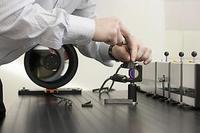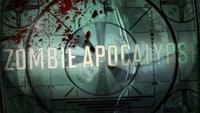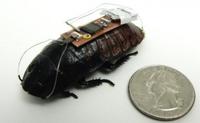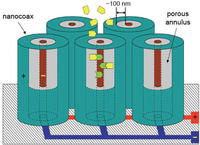-
Green laser pointer identifies traces of dangerous chemicals in real time

By using an ordinary green laser pointer, the kind commonly found in offices and college lecture halls, an Israeli research team has developed a new and portable Raman spectrometer which can detect minute traces of hazardous chemicals in real time; the new sensor’s compact design makes it a candidate for rapid field deployment to disaster zones and areas with security concerns
-
-
Imagining first responders’ high-tech future
What kinds of gear will be needed by future firefighters, EMTs, and police officers? DHS Science and Technology Directorate researchers asked the experts, then applied sophisticated math to discover unlikely patterns
-
-
New mobile app could save lives in earthquakes
A new iPhone app called has been developed to locate loved ones in the world’s earthquake zones during the event of an earthquake; the app, once downloaded, prompts users to enter their own details and those of four friends or family members in order to become their “Buddies”; in the event of an earthquake registering above 5.5, the user’s buddies will instantaneously receive an e-mail displaying a Google map of the user’s location
-
-
EU considers far-reaching Internet security initiative
Cybersecurity is becoming an increasingly more daunting challenge as governments try to prevent attacks against critical infrastructure on which the well-being of countries depends, now, several European countries are trying to come together in an effort to defend themselves against a cyber attack, but critics say the project, called CleanIT, goes too far
-
-
Keeping safe during earthquakes? There’s an app for that
The American Red Cross released its official earthquake application for iPhone and Android smartphones; the app is free, available in English or Spanish; the app includes earthquake epicenter locations, impact magnitudes, and local geographical impact data provided by the U.S. Geological Survey; it also includes a “shake zone” impact map and a one touch “I’m safe” messaging
-
-
Wearable map-creating device to help first responders
A wearable sensor system automatically creates a digital map of the environment through which the wearer is moving; the system is envisioned as a tool to help emergency responders coordinate disaster response
-
-
Maryland rolls out public safety interoperable communication system
To be better prepared for man-made or natural disasters, Maryland leaders have decided to develop Twelve Core Capacities for Homeland Security, picking the deployment of an interoperable communications system as the highest priority; on 5 June 2012, Governor Martin O’Malley inaugurated the state’s new network, known as the Maryland First Responders Interoperable Radio System Team (Maryland FiRST)
-
-
First responders train to deal with a new threat: zombie attack

A company specializing in training military units, federal, and state agencies in security, force protection, emergency response,and disaster management, has a new threat incorporated into its disaster-crisis scenario, which is part of the firm’s annual counterterrorism summit in San Diego: a zombie attack
-
-
New search-and-rescue tool: remotely controlled cockroaches

Researchers have developed a technique that uses an electronic interface to remotely control, or steer, cockroaches; remotely controlling cockroaches would allow first responders to create a mobile web of smart sensors that uses cockroaches to collect and transmit information, such as finding survivors in a building that has been destroyed by an earthquake
-
-
Alcatel-Lucent offers first-responders access to multiple video feeds using 4G LTE
New first responder video solution provides mission-critical information on handheld devices to fire, police, and ambulance services to improve responsiveness, safety, teamwork, and cost efficiency; the First Responder Video solves the network congestion problem by optimizing bandwidth use and integrating multiple video feeds and other operational data into one single stream
-
-
DHS using Boston subway system to test new sensors for biological agents

Bioterrorism is nothing new, and although medicines have made the world a safer place against a myriad of old scourges both natural and manmade, it still remains all too easy today to uncork a dangerous cloud of germs; DHS’s Science and Technology Directorate (DHS S&T) has scheduled a series of tests in the Boston subways to measure the real-world performance of new sensors recently developed to detect biological agents
-
-
Electronic nose detects airborne toxins down to the parts per billion level
Research create an electronic nose device with applications in agriculture, industry, homeland security, and the military; the device can detect small quantities of harmful airborne substances
-
-
How to act if there is a fire on a high-speed train

Researchers have used computer models to analyze the best way to evacuate the Spanish High Speed Train (AVE) in the case of fire; the involvement of the crew in organizing the fast transfer of passengers, completing the process before the train comes to a halt, and collective collaboration to assist those with reduced mobility are just some of the strategies to be followed
-
-
Court: Kentucky can continue to credit God for homeland security
The Kentucky Supreme Court has declined to hear a challenge to a state law that mandated that the commonwealth give credit to God for Kentucky’s homeland security; the Court let stand a 2011 Kentucky Court of Appeals ruling which found that a 2006 law, requiring the Kentucky Office of Homeland Security to publicize dependence on “Almighty God” in agency training and educational materials, did not violate the establishment clause in the Constitutional
-
-
Home, office WiFi could be used by emergency responders
Wireless routers for homes and offices could be knitted together to provide a communications system for emergency responders if the mobile phone network fails
-
- All
- Regional
- Water
- Biometrics
- Borders/Immig
- Business
- Cybersecurity
- Detection
- Disasters
- Government
- Infrastructure
- International
- Public health
- Public Safety
- Communication interoperabillity
- Emergency services
- Emergency medical services
- Fire
- First response
- IEDs
- Law Enforcement
- Law Enforcement Technology
- Military technology
- Nonlethal weapons
- Nuclear weapons
- Personal protection equipment
- Police
- Notification /alert systems
- Situational awareness
- Weapons systems
- Sci-Tech
- Sector Reports
- Surveillance
- Transportation
Advertising & Marketing: advertise@newswirepubs.com
Editorial: editor@newswirepubs.com
General: info@newswirepubs.com
2010-2011 © News Wire Publications, LLC News Wire Publications, LLC
220 Old Country Road | Suite 200 | Mineola | New York | 11501
Permissions and Policies
Editorial: editor@newswirepubs.com
General: info@newswirepubs.com
2010-2011 © News Wire Publications, LLC News Wire Publications, LLC
220 Old Country Road | Suite 200 | Mineola | New York | 11501
Permissions and Policies
